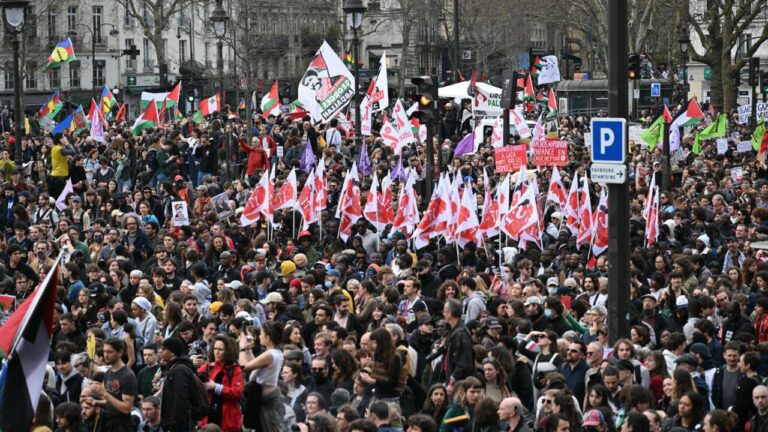Protests erupted in Paris and cities across France this week as demonstrators sought to “block everything” in a widespread show of dissent. The coordinated action, which targeted key transportation hubs and infrastructure, resulted in nearly 200 arrests as authorities moved to restore order. The unrest highlights deepening social and political tensions in the country, drawing intense attention both domestically and internationally.
Protests in Paris and Nationwide Aim to Disrupt Daily Life Amid Rising Tensions
Demonstrators across Paris and major cities in France launched coordinated efforts intended to paralyze transport, commerce, and public institutions on Tuesday. Protesters demanded government action on a range of economic and social grievances, underscoring a widespread sense of frustration amid escalating political tensions. Key locations, including transit hubs and government buildings, experienced blockades that brought significant disruption to daily life, drawing intense media coverage and prompting law enforcement to mobilize rapidly. The atmosphere was charged with confrontations between protesters and police, resulting in nearly 200 arrests by nightfall.
Authorities reported the following impacts and responses during the escalating unrest:
| Incident | Location | AuthoritiesŌĆÖ Action |
|---|---|---|
| Metro station blockade | Paris, Bastille | Deployment of riot police, area secured |
| Highway protests | Lyon outskirts | Traffic diversion and arrests |
| Public building occupation | Marseille City Hall | Negotiation and partial clearance |
The government has denounced the disruptions as unlawful, pledging to restore order and maintain essential services. Meanwhile, protest organizers continue to call on citizens to join the movement, emphasizing their intention to “block everything” until their demands receive serious government response. This unrest marks a critical moment in FranceŌĆÖs ongoing struggle with public dissent and highlights the complex challenges facing national leadership amid a fracturing social landscape.
Authorities Respond to Coordinated Demonstrations with Mass Arrests and Increased Security
Law enforcement agencies across France have mobilized unprecedented resources in response to the series of synchronized protests disrupting the capital and numerous cities nationwide. In Paris alone, police deployed riot control units equipped with shields and tear gas to contain demonstrators attempting to barricade major roads and public transport hubs. The intense clashes resulted in nearly 200 arrests, as authorities sought to dismantle blockades and prevent the protests from escalating into widespread chaos.
Security measures extended beyond active crowd control, with checkpoints established in sensitive areas and surveillance heightened to monitor potential flashpoints. The government’s robust response highlights its determination to maintain law and order amid demands that aim to “block everything,” challenging both economic activity and public safety. Below is a summary of key enforcement actions during the protests:
- Deployment of 5,000+ officers nationwide
- Use of water cannons and tear gas in congested districts
- Temporary shutdowns of metro lines in protest hotspots
- Establishment of rapid response squads for quick intervention
Analyzing the Root Causes Behind the Widespread Civil Unrest and Public Discontent
Underlying the widespread protests in Paris and beyond is a complex web of social, economic, and political grievances. Citizens have expressed deep dissatisfaction with rising living costs exacerbated by inflation, stagnant wages, and increased taxes, which together strain household budgets across demographics. Moreover, the proposed pension reforms have ignited controversies, seen by many as an attempt to erode hard-won social protections. These frustrations are compounded by a perceived disconnect between the ruling elite and the everyday struggles of common people, fueling a sentiment that the government prioritizes corporate interests over public welfare.
Adding to the volatile mix is a distrust in law enforcement and a growing sense of disenfranchisement among younger generations. Protest organizers aim to “block everything,” utilizing tactics such as transportation strikes and road barricades to amplify their demands. The movementŌĆÖs momentum is supported by a coalition of diverse groups, including labor unions, activists, and students, each pushing for systemic changes. Below is a breakdown of primary drivers behind the unrest:
- Economic Strain: Inflation rates surpassing 5%, rising fuel prices, and unemployment concerns.
- Political Discontent: Pension reform backlash and perceived governmental intransigence.
- Social Inequality: Persistent disparities in wealth distribution and access to public services.
- Erosion of Trust: Public skepticism towards political institutions and law enforcement agencies.
| Cause | Impact | Public Response |
|---|---|---|
| Rising Inflation | Reduced purchasing power | Mass demonstrations, strikes |
| Pension Reforms | Shortened retirement benefits | Widespread protests, blockades |
| Unemployment | Job insecurity | Youth-led rallies and sit-ins |
| Political Disillusionment | Low voter turnout, distrust | Calls for governmental change |
Recommendations for Stakeholders to Address Grievances and Restore Order Peacefully
Engaging all relevant parties in open dialogue remains paramount to de-escalating tensions and fostering mutual understanding. Authorities should prioritize transparent communication channels with protest leaders and civil society groups to ensure grievances are acknowledged and addressed constructively. Establishing independent mediation platforms can help bridge the gap between government decision-makers and citizens, promoting peaceful resolutions rather than confrontations.
Additionally, implementing targeted community initiatives aimed at socio-economic concerns underpinning the unrest can stabilize affected neighborhoods and restore public confidence. Key steps include:
- Enhanced community policing with a focus on de-escalation training
- Investment in local social services to address unemployment and welfare issues
- Regular public forums to maintain ongoing communication
- Support mechanisms for victims of violence or property damage
| Stakeholder | Recommended Action | Expected Outcome |
|---|---|---|
| Government | Facilitate mediation and transparency in reforms | Reduced public distrust |
| Law Enforcement | Adopt non-violent tactics and engage community leaders | Lower incidence of violent clashes |
| Civil Society | Organize peaceful assemblies and dialogue sessions | Strengthened community cohesion |
Insights and Conclusions
As demonstrations continue to ripple across Paris and other parts of France, authorities remain on high alert amid efforts to “block everything” and disrupt daily life. With nearly 200 arrests reported, the protests highlight the growing tensions between the public and the government. Observers will be watching closely to see how officials respond to the unrest and what impact the sustained demonstrations will have on the nationŌĆÖs social and political landscape moving forward.




